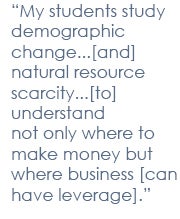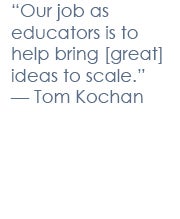How might we move closer to an economy where the president’s aspiration becomes less of an exception and more of the norm? Think Costco, which has one of the most competitive benefits packages in the industry and Southwest, a company well known for its low consumer prices and work perks which have built a strong company culture. More than 100 business school deans, university faculty, and business practitioners met at the Ford Foundation in New York City for the Business Education Symposium late last year to explore this very question.
Business education is sometimes criticized for being too theoretical and far removed from business practice. The Symposium is designed to turn that criticism on its head – first by bringing together academia and business leaders, second by focusing on questions of deep importance to our economy and our society, and third by focusing on teaching.
One might think that academics come together often to exchange ideas about their craft — but, in fact, academic conferences are almost always focused on research. At the Symposium, participants discussed — and in some cases, experienced — real-life examples of exceptional teaching and curriculum. Grounded in this unique premise, participants imagined what might be possible in MBA education and how to make critical changes in business schools. In addition to digging into questions about exceptional employment practices, Symposium sessions focused on two additional themes: responsible sourcing in the supply chain (how firms can buy palm oil, or cotton, in ways that support local economies) and the relationship between business and government.
Business has a responsibility to address inequality in our society and it starts with business education. Here are five calls to action that emerged from this two-day dialogue:

1. Teach the Big Picture
Teaching the big picture — the larger social context in which business decisions play out — is not a typical practice in MBA education right now, but doing so may help students raise new questions about business practices when it is their turn to lead.
One Symposium participant noted that many employers today are shocked to hear that their employees require public assistance. What would need to be true of MBA curriculum so that future employers would naturally consider the impact of employment practices not only on operational performance, but also on their employees’ quality of life?
2. Look for New Points-of-Entry
In the MBA curriculum, where can conversations happen about having ethical and socially responsible employment practices? An obvious answer is organizational behavior or operations classes. But by addressing sustainable sourcing and employment practices in less likely contexts — e.g., in strategy, accounting, and entrepreneurship courses — new questions arise.
For example, what is the relationship between high-road practices (paying fair wages, providing paid sick leave, etc.) and a firm’s business model, culture, and incentive systems? How are these practices being shaped by the laws, regulations, and policies of the country or countries in which the company operates?
3. Forge Across Disciplinary and Institutional Boundaries
Participants spoke with a sense of urgency and momentum about the need to push interdisciplinary and institutional change to better integrate real world problems into the classroom. Participants were excited about problem-based courses or courses rooted in phenomena — such as climate change, demographics, and big data — as powerful opportunities for faculty to reach across the aisle more so than courses anchored in a particular discipline.
For example, bringing a sociologist together with a business strategist to teach about today’s workforce and tomorrow’s economy may seem like a no-brainer, but traditionally, academia emphasizes teaching theory over real-world training. Combined with a tenure process that rewards a narrow disciplinary focus, and larger institutional dynamics like budget restrictions, faculty collaboration in the classroom often falls to the bottom of the list.

4. Get Students “Unsteady”
In order to cultivate leaders who not only have, but act upon virtuous values, we need to shake things up. Getting students unsteady requires inspiring curiosity and developing comfort with ambiguity. It also requires taking a fresh look at both content and pedagogy. On content, participants broadly agreed that MBA students are not exposed in a deep and nuanced way to the notion of market failures. Also, course content often focuses only on success stories (naming and acclaiming the Unilevers of the world), which may conceal some uncomfortable truths about the social performance of the business sector at large.
5. Heed the Mission
Mission statements at many business schools aspire to produce leaders who make a difference in the world. Leading up to the Symposium, the Aspen Institute Business & Society Program and Korn-Ferry conducted interviews with a group of business school deans and learned that these missions are very real guideposts for deans as they navigate their increasingly complex roles. Still, there is a sense that these missions may not have the permeating effect on MBA curriculum that one might hope.
Symposium participants urged one another to use the mission statements at their own institutions as inspiration as they advocate for and implement curricular change.
RELATED CONTENT:
- Report: Meeting Our Highest Aspirations for Capitalism
- Explore syllabi from Pioneer Award Winning Faculty
- Video: Symposium panel featuring business school leaders
Trisha King is the program coordinator and Claire Preisser is the senior program manager of the Business and Society Program at the Aspen Institute.

